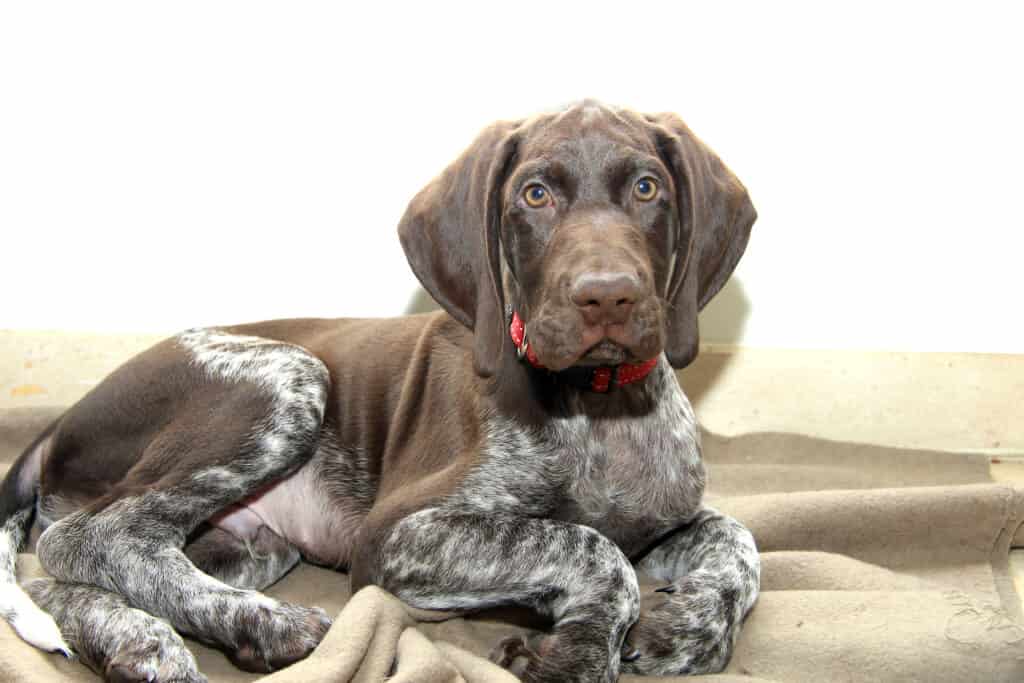Our website is supported by our users. We sometimes earn money when you click an affiliate link and make a purchase. This is at no extra cost to you and helps us to create quality content. Thank you for your support. For all that have shown us such wonderful support, we thank you from the bottom of our hearts!
The German Shorthaired Pointer (GSP) is a versatile dog breed known for its proficiency in hunting and its friendly, cooperative nature.
Developed in the 19th century in Germany for hunting, these dogs are renowned for their athletic build and possess a keen sense of smell, making them excellent at tracking and retrieving game in both land and water environments.
With a coat that is solid liver or a combination of liver and white, these medium-sized gundogs are as striking in appearance as they are in agility and intelligence.
They are smaller than English Pointers in height and weight.

While their hunting capabilities are legendary, German Shorthaired Pointers also make for eager and affectionate companions.
Their high energy levels and intelligence mean they require regular exercise and mental stimulation, making them an ideal fit for active individuals or families who can provide them with the physical activity and training they crave.
Training a GSP can be a rewarding experience due to their eager-to-please disposition and quick learning ability.
However, potential owners should be aware of the responsibilities that come with such a high-spirited breed, including consistent training and socialization.
Regarding health, German Shorthaired Pointers are generally healthy but, like many breeds, are prone to certain hereditary health conditions.
Regular veterinary check-ups, proper nutrition, and preventive care are key to ensuring a long and healthy life for a GSP.
Maintenance involves routine grooming that helps manage their short coat and keeps shedding to a minimum.
Key Takeaways
- The German Shorthaired Pointer excels in hunting and is a loyal companion.
- Routine exercise and training are essential for their physical and mental well-being.
- Health and grooming require attention to prevent common breed-specific issues.
History of the German Shorthaired Pointer
Your interest in the German Shorthaired Pointer (GSP) leads you to its history, which is deeply rooted in Germany’s hunting traditions.
The breed’s development dates back to the early 1800s, where the objective was to create a versatile hunting dog capable of both pointing and retrieving game.
The creation of the GSP involved the systematic crossing of various breeds, including the Spanish Pointer, to enhance hunting attributes.

The resulting breed, with its keen nose and agile body, is suited for both land and water—which explains the GSP’s enduring popularity.
In the 1800s, German hunters continued refining these dogs, ensuring they possessed traits like intelligence, strength, and endurance.
They achieved such success that GSPs have remained top contenders in competitive hunting events to this day.
Characteristics of the GSP, such as its strong legs and great endurance, are a testament to the purposeful breeding strategies employed during its origin.
These traits, combined with its eagerness to please owners, have made your GSP not just a capable hunter but also a loyal companion.
The history of the GSP, from its early use in hunting with nets and falconry in Mediterranean countries, to becoming the well-known and loved breed you see today, is compelling.
Your understanding of its background enriches the bond you share with your GSP, rooted in a tradition of hunting excellence that extends far beyond Germany’s borders.
Physical Characteristics of the German Shorthaired Pointer

As a robust and versatile hunting dog, the German Shorthaired Pointer (GSP) boasts a distinct appearance defined by its athletic build, functional coat, and expressive eyes. Here’s what you should know about the physical traits of this breed.
Height Male
Males typically stand between 23 to 25 inches at the shoulder, reflecting their large size.
Height Female
Females are slightly smaller, with a standard height ranging from 21 to 23 inches.
Weight Male
A healthy male German Shorthaired Pointer has a weight that usually falls between 55 to 70 pounds.
Weight Female
Female GSPs are generally lighter, with weights ranging from 45 to 60 pounds.
Eye Colors
The eyes are often almond-shaped and may come in various shades, commonly exhibiting dark brown hues that convey an alert and intelligent expression.
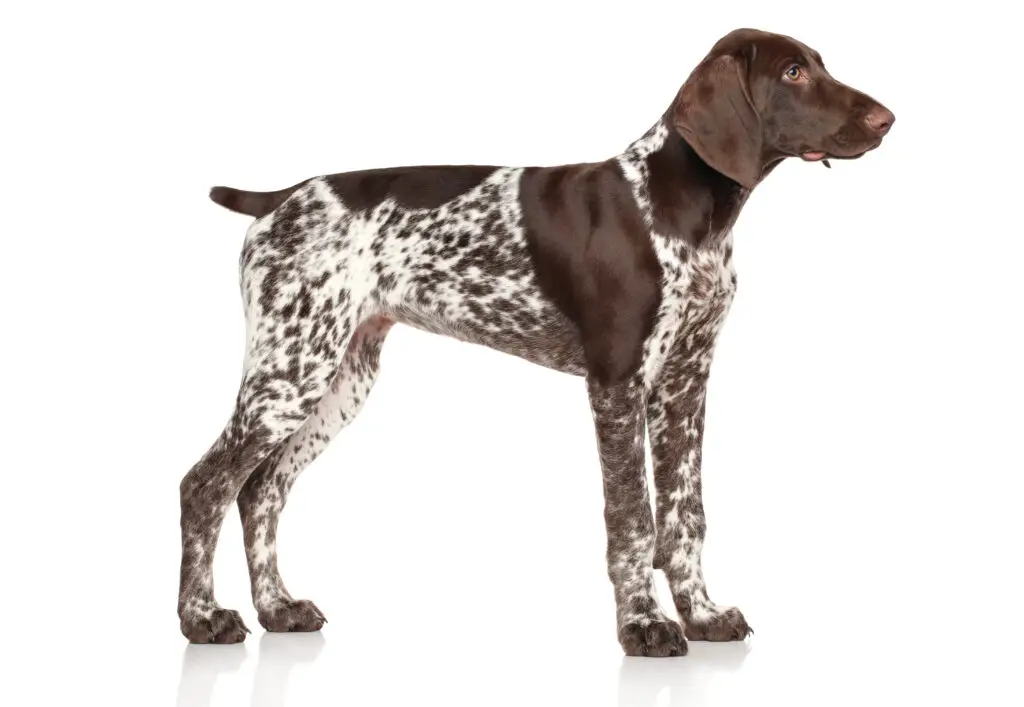
Coat Colors
Their coat exhibits a range of colors, mostly liver, liver and white, liver roan, or liver and ticked, offering a distinctive, speckled appearance.
Coat Types
The GSP has a short and thick coat that is both functional for outdoor activities and easy to maintain, typically being slightly coarse to the touch.
Life Expectancy
With proper care, your German Shorthaired Pointer can be expected to live 12 to 14 years, enjoying a life full of activity and companionship.
Temperament & Training of the German Shorthaired Pointer
German Shorthaired Pointers (GSP) are known for their friendly temperament, marked by a playful and eager-to-please attitude.
So if first-time owners understand that they have a high energy level, requiring much exercise and mental stimulation, then they will make great family dogs for an active family.
Recognized for their intelligence and trainability, GSPs excel in various canine field events, including dock diving, agility and rally.
If raised together, German Shorthaired Pointers (GSPs) and young children can develop close relationships.
They are excellent playmates for older, more energetic kids because of their high activity level. However, toddlers and small children could find their energy too overwhelming.
GSPs have a high prey drive and they are bred to hunt small animals.
Unfortunately, they may not be able to differentiate between small wild animals and small pets like rabbits, mice, guinea pigs, etc.
Pet parents, make sure your GSP and your other small pets avoid spending time alone together.
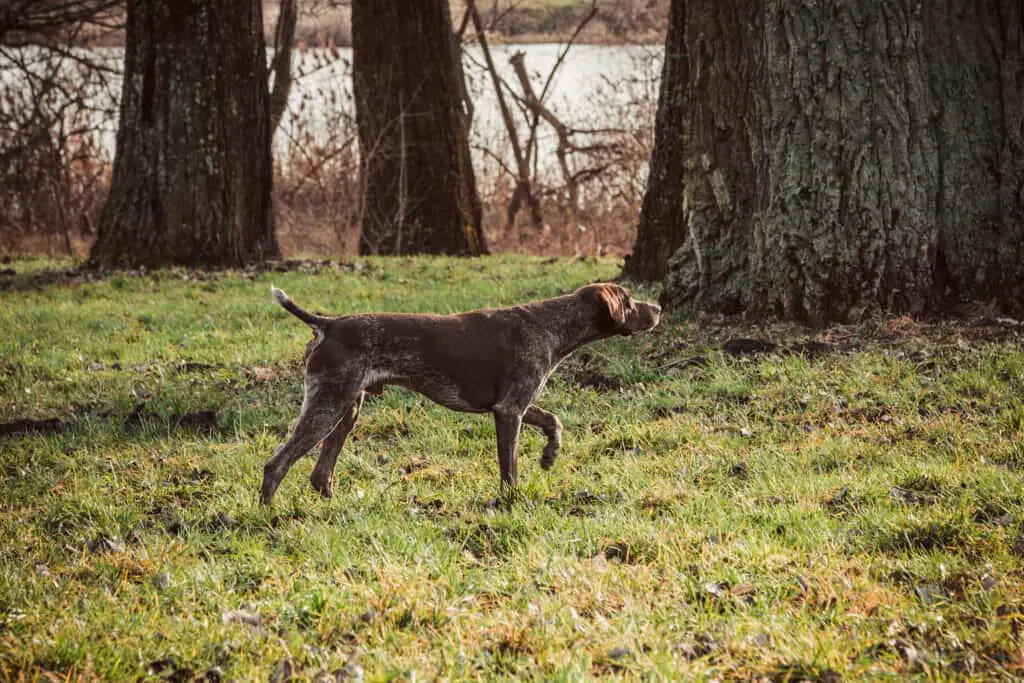
Training Your GSP:
It’s crucial to start obedience training early, as these dogs are very intelligent and learn quickly. Your GSP’s trainability makes teaching basics of obedience a smoother process.
However, keep training sessions engaging and challenging to cater to their high energy and curiosity. And as with any great dog, start proper socialization early.
- Socialization: Introduce your GSP to new people and environments to develop their friendliness.
- Positive Reinforcement: Reward good behavior to reinforce their desire to learn and please.
- Consistency: Maintain regular training sessions to keep their obedience sharp.
| Aspect | GSP Features |
|---|---|
| Temperament | Friendly, intelligent, playful, eager to please |
| Energy Level | High, necessitates physical activities such as running, and mental engagement |
| Trainability | Excellent, responds well to obedience training and agility exercises |
| Companion Suitability | Suited for active owners who can match their energy and commitment to training |
By providing your energetic GSP with structured training and outlets for their energy, you will be rewarded with a loyal and skilled companion, capable of performing at high levels in various activities.
Remember, playfulness isn’t just a trait, it’s an opportunity to bond and learn together.
Health Issues of the German Shorthaired Pointer
Your German Shorthaired Pointer (GSP) is known for its energy and athleticism, but like all breeds, they have certain health challenges that you should be aware of.
Being informed can help you take proactive measures to care for your dog’s well-being.
Common Health Problems:GSPs may encounter several hereditary health issues, including:
- Hip Dysplasia: This is a genetic condition where the thighbone doesn’t fit snugly into the hip joint, which can lead to arthritis or mobility issues. Look for signs like difficulty in rising or a reluctance to exercise. More on hip dysplasia.
- Epilepsy: This neurological disorder can lead to seizures. While it can be concerning to witness, epilepsy is often manageable with medication.
- Cancer: While it’s a common concern in many dog breeds, prompt detection and treatment can make a significant difference. Regular health check-ups are crucial.
Preventive Measures:
- Routine Check-ups: Early diagnosis through regular veterinary visits can lead to more effective management of these health issues.
- Diet and Exercise: Maintaining a healthy weight through diet and regular activity can reduce the stress on joints, potentially alleviating the symptoms of hip dysplasia.
- Genetic Testing: If you’re considering breeding or are curious about your GSP’s health risks, genetic testing can provide insights into their predisposition to these conditions.
By understanding these potential health problems and taking steps to prevent or manage them, you can help ensure that your German Shorthaired Pointer leads a healthy, active life.
Grooming Your German Shorthaired Pointer
Grooming your German Shorthaired Pointer involves regular care tailored to their short, dense coat and active lifestyle.
Proper grooming helps to minimize shedding and maintain their overall well-being.
Brushing
Your German Shorthaired Pointer’s coat benefits greatly from weekly brushing.
This routine removes loose fur, distributes natural oils, and keeps the coat shiny.
Use a grooming glove or a bristle brush that can gently capture the shed fur without irritating the skin.
Bathing
Bathing your dog should be done sparingly, about every few months, unless they get particularly dirty.
When you do bath them, it’s essential to use a dog-friendly shampoo and thoroughly rinse their coat to prevent irritation or dandruff.
This massager really gets the soap and all of it’s soothing ingredients down to your dog’s skin.
Cutting Fur/Hair
The short coat of a German Shorthaired Pointer generally doesn’t require trimming.
However, you should inspect their fur regularly for any burrs or tangles, especially after outdoor activities, and remove them promptly.
Clipping or Grinding Nails
Regular nail care is crucial; long nails can lead to discomfort or foot problems.
Clip or grind their nails as needed, usually once or twice a month, being careful not to cut into the quick, which can cause bleeding.
If you accidentally cut the quick, dip their nails in Styptic Powder.
Also, you can check out our article on How to Grind Your Dog’s Nails.
And How to Clip Your Dog’s Nails Safely.
Dental Care
Dental health is part of your dog’s overall care regime.
Brush their teeth several times a week using a canine toothbrush and toothpaste to prevent tartar buildup and maintain healthy gums.
Cleaning Ears
Pay close attention to your dog’s ears.
Cleaning their ears should be a gentle process, using a vet-approved cleaner to wipe away dirt and wax.
For an easy fix, you can use the Pet MD – Dog Ear Cleaner Wipes – Otic Cleanser for Dogs.
This prevents the buildup that can lead to infections especially in dogs with floppy ears.
Owning a German Shorthaired Pointer
Owning a GSP dog involves understanding the financial commitment and responsibilities that come with adding this energetic and affectionate breed to your family.
They require ample exercise, a nutritious diet, and dedicated training.
Cost of Purchase
When considering adding a German Shorthaired Pointer to your family, the initial purchase price can vary widely.
For a purebred GSP puppy, you might expect to pay anywhere from $600 to $1,500.
Prices can fluctuate based on breeder reputation, location, bloodlines, and whether the puppy is destined for the show ring or as a family pet.
Maintenance Costs
The maintenance costs for a GSP go beyond the initial purchase price.
This breed requires a balanced diet, routine veterinary care, including vaccinations and regular health checks, and preventative measures for parasites.
The diet of a German Shorthaired Pointer should be high-quality and match their high energy levels.
| Expense Category | Estimated Annual Cost |
|---|---|
| Food | $250 – $700 |
| Veterinary Care | $200 – $500 |
| Supplies & Toys | $50 – $200 |
| Training Sessions | $50 – $300 |
Don’t forget to factor in additional costs such as grooming supplies or professional services, as well as any dog walking or pet insurance you may consider necessary.
Adopting a German Shorthaired Pointer
Adopting from a rescue can be a rewarding way to find your GSP.
Adoption fees are generally lower than purchasing from a breeder and typically range from $50 to $300.
This fee usually covers spaying/neutering, vaccinations, and sometimes a microchip.
By rescuing a GSP, you’re not only giving a dog a second chance but also potentially saving on the initial cost of bringing a pet into your home.
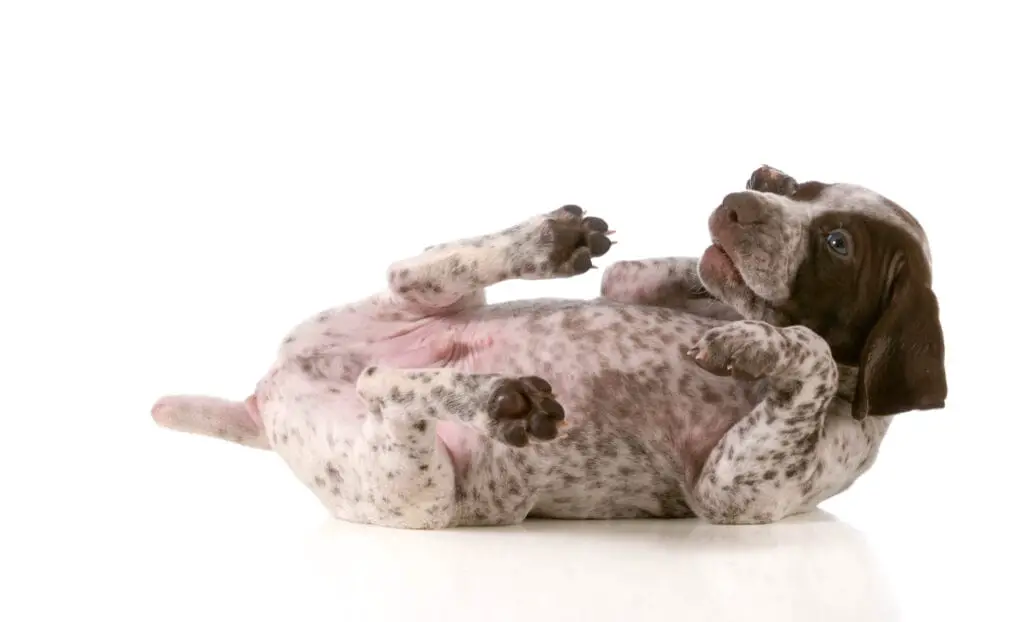
Finding Reputable Breeders
Selecting a reputable breeder is crucial when purchasing a German Shorthaired Pointer.
Research to find breeders who excel in the breeding of German Shorthaired Pointers who perform health screenings and raise puppies in a family environment.
Expect breeders to ask you questions as they want to ensure their puppies are going to good homes.
You may visit vetted breeders through organizations like the American Kennel Club.
Please note, while costs are important, so is the well-being of the pet.
Ensure that you understand the breed’s needs for exercise, mental stimulation, and companionship.
GSPs are known for their loyalty and thrive in an environment where they are part of the family’s daily activities.
They typically get along well with children and other pets if introduced and socialized properly from a young age.
Frequently Asked Questions
In this section, you’ll find concise answers to some of the most common queries about German Shorthaired Pointers, helping you understand their cost, size, temperament, lifespan, shedding, and suitability for families.
How much does a German Shorthaired Pointer typically cost?
The price of a German Shorthaired Pointer can vary based on factors like lineage and location, but you can generally expect to pay between $500 to $1,500 for a puppy from a reputable breeder.
What is the average size and weight of a German Shorthaired Pointer?
Males typically stand 23 to 25 inches at the shoulder and weigh 55 to 70 pounds, while females are usually 21 to 23 inches tall and weigh 45 to 60 pounds.
Could you describe the typical characteristics and temperament of a German Shorthaired Pointer?
German Shorthaired Pointers are energetic, intelligent, and eager to please. They have a high prey drive and are known for being affectionate and good-natured with family.
What is the expected lifespan of a German Shorthaired Pointer?
These dogs typically live between 12 to 14 years when provided with proper care and nutrition.
How much shedding should one expect from a German Shorthaired Pointer?
You can expect a German Shorthaired Pointer to shed moderately throughout the year, with seasonal increases usually occurring twice annually.
Are German Shorthaired Pointers well-suited for family life and living with children?
Yes, with their friendly and patient demeanor, German Shorthaired Pointers can be excellent companions for families and generally do well with children when properly socialized.
Conclusion: Bottom Line on the German Shorthaired Pointer
The German Shorthaired Pointer (GSP) stands out for its versatility, both as a hunting companion and a family dog.
Your understanding of the GSP breed should highlight its energetic personality and strong hunting instincts.
- Temperament: GSPs are known to be affectionate, intelligent, and eager to please, requiring regular interaction and mental stimulation.
- Exercise Needs: High; they demand active daily exercise to sustain their muscular build and endurance.
- Swimming Ability: Their webbed feet make them natural swimmers.
- Coat Care: With a short coat, they are low maintenance but can be sensitive to cold.
Training should start early, harnessing the breed’s intelligence and desire to learn.
Given their drive and athleticism, GSPs excel in various canine sports and activities.
Companionship is crucial; they thrive on interaction and may become destructive if bored or left alone for long periods.
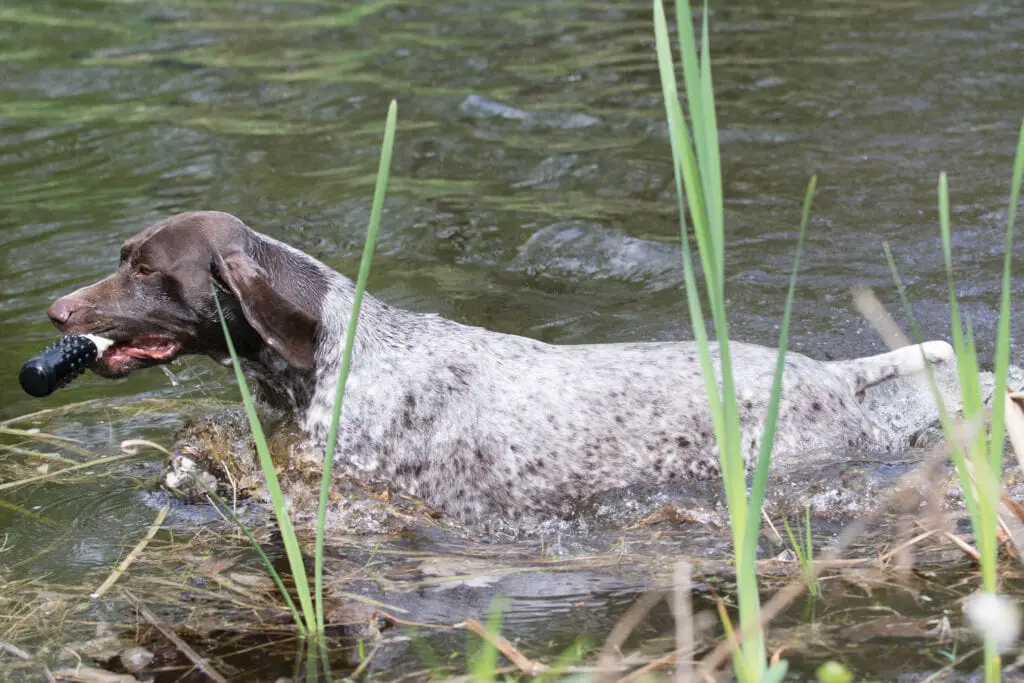
The breed’s history is deeply entrenched in hunting, also evident in its characteristics and abilities.
You’ll find their loyalty and protectiveness make them superb guard dogs as well.
But, it is essential to understand that their vigor needs an outlet, a task that requires your commitment.
Your research on the GSP should prepare you for a rewarding relationship, provided you can meet the demands of this spirited breed.
The GSP’s adaptability to various environments and tasks makes it a worthy addition to an active household.
Please read our Legal Disclaimer

